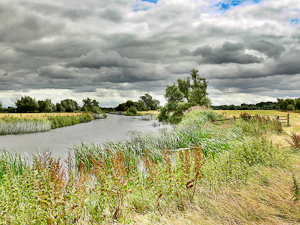A) Advaita Vedanta can be called a mystical path, a spirituality, science of reality, or a combination of both (which I prefer). It can be called nonduality or ‘Monism’ (preferably the first): monism because it takes reality as being One (“without a second”). Nonduality because – though reality is one in essence or ultimately – it presents itself as apparently two: purusha-prakriti, Self- not self, sat-asat, subject-object, Atman-brahman. That apparent dichotomy, as stated, is reducible to the one reality which can be called variously ‘pure consciousness’, ‘the absolute’, ‘sat-chit-ananda’ (being-consciousness-bliss)… the unnamable. Words – language – are secondary, needed to express what is in itself inexpressible. What is inexpressible can be/is a (self) realization of ‘what is’ (anubhava) arrived at by intuition and (Vedantic) reasoning. Continue reading
Tag Archives: berkeley
Q. 393 – Idealism or Realism?
Q: Advaita often uses certain language and metaphors, and these can often come across as sort of a “subjective idealism plus”. Where subjective idealism argues that the “outside world” is a completely nonexistent illusion produced in a mind, Advaita sometimes seems to say yes, that’s true – only, behind that mind that imagines the world is consciousness witnessing the mind, which is “projected” onto consciousness by the mysterious maya. In other words, Berkeley was right, only he didn’t go far enough. This leaves Advaita sounding like total solipsism, blended with hardline idealism. Consciousness, some sort of unimaginable void incapable of anything, is having a mind and a world “imagined” onto it by maya, which despite the incapability of consciousness to do anything is still a “power” of that consciousness. (Of course, this is very much a conceptualization, taking these metaphors too literally and looking at these terms and concepts through a very Westernized lens. But this is often the way some teachings sound!)
But in addition to the talk of all things being total illusion, I will also hear that Advaita is realist – that the universe is not a hallucination; that it is, in one sense, “actually there”; and that it is in comparison to the changeless paramarthika viewpoint that vyavahara is “unreal”. This position makes much more sense to me than imagining the universe to be some sort of magic trick.
Now, I recognize that these explanations – both of them – are attempts to “point” at truth, and not a tidy description of truth itself. Ultimately, there is only brahman; there are no “illusory things” and no “real things”. But I’m far from truly grasping that yet, so I suppose my question is: which of these descriptions more accurately reflects the nature and relation of vyavahara and paramartha? Or are both illustrations only as useful as what they can communicate to a student? Or am I just getting way too caught up in concepts here? Continue reading
Overview of Western Philosophy – Part 8

(Read Part 7 of the series.)
Empiricism and Idealism Locke and Berkeley)
Empiricism
Born some eighteen years before the death of Descartes, the Englishman John Locke claimed that reason was not the principal means for finding out about the world, as the earlier philosopher had contended. Instead, he advocated an empirical approach to knowledge, i.e. using one’s senses actually to see what is the case. This is the only means for obtaining raw data and we use reason subsequently to make sense of it. Only then can it become knowledge. He believed his own purpose in life was to enquire into human knowledge to discover its limits and the extent to which we could be certain of it.
Unlike modern, evolutionary psychologists, he believed that we are effectively born with no innate knowledge, a metaphorical ‘blank slate’. All of our knowledge and understanding is therefore built upon information derived from our senses. Everything we know or think about ultimately comes from experience. The limits of what we can know about reality are fixed by the abilities of the senses and the associated mental equipment. Continue reading
Advaita is not Idealism
 (Originally posted to Advaita Academy Nov 2010)
(Originally posted to Advaita Academy Nov 2010)
All students of advaita know that every ‘thing’ is brahman. And they know that ‘I am brahman’. It is therefore a trivial mathematical reduction to say that everything is me. But there is a danger here. Some people conclude that the world is an appearance that ‘I’ create in some way; that the world ‘is’ because I perceive it. In this way, such people claim that advaita is equivalent to the subjective idealism of the Western philosopher Berkeley, who said “to be is to be perceived” (esse est percipi). This, of course, is a denial of the separate existence of matter and this might naïvely be thought to be equivalent to the Advaitin concept of mithyA.
(Note that the word ‘ idealism’ has nothing to do with aiming for perfection, but means that things have no reality in themselves, only existing as ideas in mind.)
From the point of view of absolute reality, there is only brahman. But then there is nothing to talk about! Such a discussion is only meaningful from the standpoint of empirical reality – our everyday world. If subjective idealism were true, the world would cease to exist when we go to sleep and would have to be created anew on awakening. Berkeley got around this sort of problem by claiming that the world continues to exist because it is perceived by God. And again, one might be tempted to claim that this parallels advaita in that we claim that the world is a creation of Ishvara, rather than the individual. This is not quite the case. In advaita, objects really do exist. Ishvara is the material cause, as well as the efficient cause of the universe. The point is that the substratum of their existence is brahman alone. In the case of Berkeley, however, the objects only exist in the mind of God, as it were.
Greg Goode, who studied Berkeley for his doctorate, believes that Berkeley’s last book may well have resolved his views to match those of advaita, but there were very few copies of that book ever made and it has not been possible to confirm this.
Advaita, then, does not claim that objects have no reality separate from the subject at the level of the world. In this sense, it is a realist philosophy and not an idealist one. This is highlighted by the following very interesting analysis, which I recently came across in one of the talks by Swami Paramarthananda on the Brahma Sutra.
Our principal pramANa, or source of knowledge, is pratyakSha or perception. When we see something for the first time, we see it in the present and, as a result of the examination of its various attributes, we conclude what it is. We can call this ‘cognition’. At some time in the future, we may encounter an object. By comparing its attributes in the present with remembered attributes from the past (as retrieved from the memory), we may be forced to conclude that this object is the same one that we saw in the past. This is called ‘recognition’ – seeing the object again. This fact of recognition is effectively a refutation of idealism (which is also the philosophy of the yogachAra or vij~nAna vAda Buddhists, a branch of Mahayana Buddhism). If the object that is seen now is the same object as the one that was seen in the past, then clearly it has a real existence and is not only an appearance in mind (which might otherwise be called a figment of the imagination).
You can read a series of essays from Chittaranjan Naik on ‘A Realist View of Advaita’.
Q. 357 – Existence of Objects
Q. Dear Dennis,
I bought and read two of your ebooks and liked them so much then I looked at your blog and came across this:
http://advaita-academy.org/blogs/DennisWaite.ashx?Y=2010&M=November
You say objects really exists, Advaita is not idealism, it is realism. I don`t understand this, in your book you use dream metaphor, you use “cinema” metaphor you even said in your book:
“He goes on to explain that our normal states of consciousness – waking, dream and deep sleep – are at the level of appearance. Reality is the non-dual background to these states. Just as our dreams seem real to the dreamer, so this world-appearance seem real to the waker. But, on waking, it is realized that those dreams are nothing but an illusion generated by the mind.
Similarly only on awakening to god-consciousness will you appreciate and realize the staggering truth that there exists nothing other than Brahman everywhere. Until that supreme state is reached, the universe will appear real. Living in your present state of ignorance you will have to accept the world that you experience. But at the same time try to contemplate and realize the truth proclaimed by Self-realized souls that Brahman alone exists.”
So you changed your mind after writing the book and now you say World-appearance is real, Advaita is realism and there is no illusion at all?
I`m confused, can you explain? Continue reading
